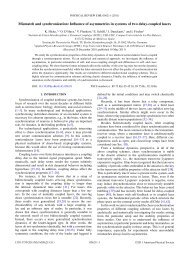DBI Analysis of Open String Bound States on Non-compact D-branes
DBI Analysis of Open String Bound States on Non-compact D-branes
DBI Analysis of Open String Bound States on Non-compact D-branes
Create successful ePaper yourself
Turn your PDF publications into a flip-book with our unique Google optimized e-Paper software.
CHAPTER 6. SETTING 81It was menti<strong>on</strong>ed above that <strong>compact</strong> D-<strong>branes</strong> coined between two NS5-<strong>branes</strong> alsoexhibit bound states. These bound states are massless. C<strong>on</strong>trary to this, it has beenshown in [3] that the spectrum <str<strong>on</strong>g>of</str<strong>on</strong>g> the bound states appearing <strong>on</strong> n<strong>on</strong>-<strong>compact</strong> D-<strong>branes</strong>in the close vicinity <str<strong>on</strong>g>of</str<strong>on</strong>g> the NS5-ring have a small mass. Recalling that these statesare bound in the x 6 directi<strong>on</strong>, they can <strong>on</strong>ly move in the x 0,1,2,3 directi<strong>on</strong>s anymore,which corresp<strong>on</strong>d exactly to a 4D-Minkowski space-time. It has been proven, still in [3],that these massive bound states corresp<strong>on</strong>d to massive gauge bos<strong>on</strong>s in a 4D Minkowskispace-time. This is very interesting, because it allows for yet another building block <str<strong>on</strong>g>of</str<strong>on</strong>g>the Standard Model to be recreated in string theory. Even though it is not yet fullyunderstood how to use this piece <str<strong>on</strong>g>of</str<strong>on</strong>g> the Standard Model puzzle, at least it is sure to bepresent. This result was shown using exact computati<strong>on</strong>s in a c<strong>on</strong>formal field theoreticalapproach. The advantage <str<strong>on</strong>g>of</str<strong>on</strong>g> this approach is that it is exact. The drawback however isthat such a c<strong>on</strong>formal field theoretical formulati<strong>on</strong> is <strong>on</strong>ly known for a limited number<str<strong>on</strong>g>of</str<strong>on</strong>g> setups, and in particular it is not known in the regi<strong>on</strong> far away from the NS5-ring.On the other hand, the <str<strong>on</strong>g>DBI</str<strong>on</strong>g> approach is easily generalizable to this regi<strong>on</strong>, but is <strong>on</strong>lyvalid when the space-time curvature is small at the string length scale. Hence, it isinteresting to find out to which extend both methods agree in the regi<strong>on</strong> where they areboth applicable, so as to be able to judge if whether or not the approximate formulati<strong>on</strong>is exact enough to be useful in the far-away regi<strong>on</strong>.Returning to the factorized space-time, remark that since we assumed our D4-braneto live in x 0,1,2,3,6 , it also gets factorized, namely into a D3-brane living in x 0,1,2,3 , and aD1-brane living in the trumpet geometry. However, we are faced with the problem thatthe trumpet geometry explodes as r −→ 0 (see Eq. 6.9 and Fig. 6.4). The problem liesin the fact that, as can be seen from Eq. 6.9, as r approaches 0, e Φ −→ ∞, indicatingthat we can no l<strong>on</strong>ger assume the coupling to be weak. As such, if we want to use the<str<strong>on</strong>g>DBI</str<strong>on</strong>g> acti<strong>on</strong>, we should c<strong>on</strong>sider extra terms in a perturbative g s expansi<strong>on</strong>.Figure 6.4: Graphical representati<strong>on</strong> <str<strong>on</strong>g>of</str<strong>on</strong>g> the trumpet (l) and cigar (r) geometries.
















